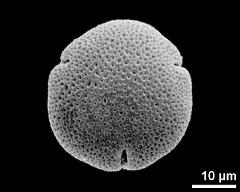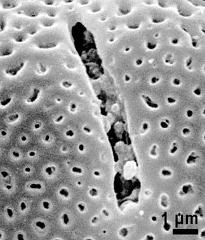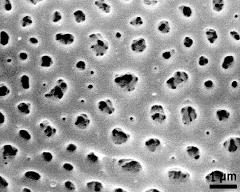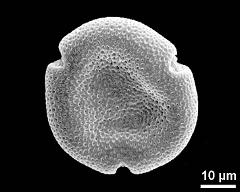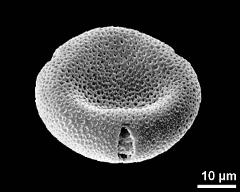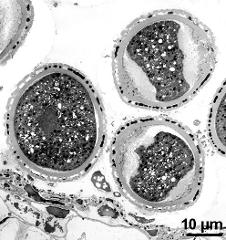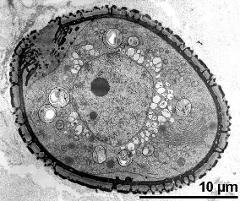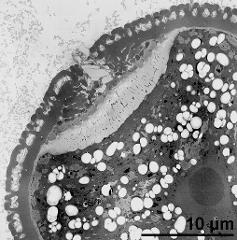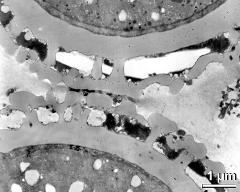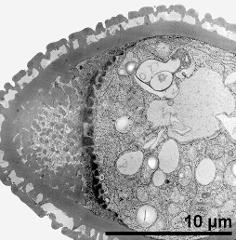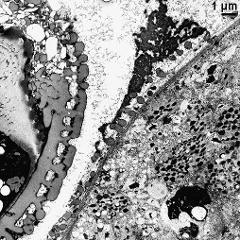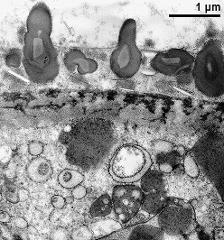Tilia platyphyllos
Taxonomy: Spermatophyta, Malvales, Tiliaceae, Tilia
Published: 2005-06-01
Pollen Description
Shape, Size and Aperture
pollen unit: monad, dispersal unit and peculiarities: monad, size (pollen unit): small (10-25 µm), size of hydrated pollen (LM): -, shortest polar axis in equatorial view (LM): -, longest polar axis in equatorial view (LM): -, shortest diameter in equatorial or polar view (LM): -, longest diameter in equatorial or polar view (LM): -, pollen class: -, polarity: isopolar, P/E-ratio: oblate, shape: -, outline in polar view: circular, dominant orientation (LM): -, P/E-ratio (dry pollen): oblate, shape (dry pollen): -, outline in polar view (dry pollen): circular, infoldings (dry pollen): -, aperture number: 3, aperture type: -, aperture condition: colpate, aperture peculiarities: -
Ornamentation and Structure
LM ornamentation LM: -, nexine: -, sexine: -, SEM ornamentation SEM: microreticulate, suprasculpture SEM: -, TEM tectum: semitectate, infratectum: columellate, foot layer: continuous, endexine: absent, intine: monolayered, wall peculiarities: -, supratectal element: -
Miscellaneous
pollen coatings: pollenkitt, reserves in cytoplasm: starch, cell number: -, Ubisch bodies: present
Annotations: endexine restricted to apertures
Author(s) of diagnosis: Halbritter, H.; Hesse, M.
Pictures
Picture legend
- polar view - fresh, rehydrated (water) & critical point dried & sputter coated with gold, photographer: Halbritter, H.
- detail of aperture - fresh, rehydrated (water) & critical point dried & sputter coated with gold, photographer: Halbritter, H.
- exine surface - fresh, critical point dried, photographer: Halbritter, H.
- polar view of dry pollen grain - dry, sputter coated with gold, photographer: Halbritter, H.
- dry pollen grain in equatorial view - dry, sputter coated with gold, photographer: Halbritter, H.
- pollen grains and part of tapetum wall (bottom) - fresh, glutaraldehyde & osmium, uranyl acetate & lead citrate, photographer: Hesse, M.
- hydrated pollen grain - fresh, glutaraldehyde & osmium, uranyl acetate & lead citrate, photographer: Hesse, M.
- aperture - fresh, glutaraldehyde & osmium & potassium ferrocyanide, uranyl acetate & lead citrate, photographer: Hesse, M.
- detail of pollen wall - fresh, glutaraldehyde & osmium, uranyl acetate & lead citrate, photographer: Hesse, M.
- aperture - fresh, glutaraldehyde & osmium & potassium ferrocyanide, uranyl acetate & lead citrate, photographer: Hesse, M.
- pollenwall (left) and tapetum wall with Ubisch bodies - fresh, glutaraldehyde & osmium & potassium ferrocyanide, uranyl acetate & lead citrate, photographer: Hesse, M.
- Ubisch bodies on locule wall - fresh, glutaraldehyde & osmium & potassium ferrocyanide, uranyl acetate & lead citrate, photographer: Hesse, M.
Literature
- (1976) The pollination biology of Tilia. Amer J Bot 63: 1203-1212
- (1961) The fine structure of the pollen wall of Tilia platyphyllos. New Phytol 3?: 393-399
- (1971) Scanning electron microscopy of Tilia pollen. New Phytol 70: 687-692
- (1993) Pollenkitt development and composition in Tilia platyphyllos (Tiliaceae) analysed by conventional and energy filtering TEM. Pl Syst Evol, Suppl 7: 39-52
Copyright and Citation
Cite this publication as:
Halbritter H., Hesse M. 2005. Tilia platyphyllos. In: PalDat - A palynological database. https://www.paldat.org/pub/Tilia_platyphyllos/109978;jsessionid=1E03CA5356375256E0F3891C4EDF1D66; accessed 2024-04-24

